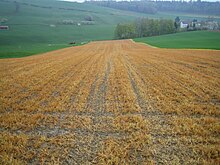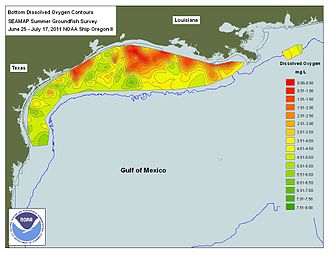Agricultural chemistry
Agricultural chemistry is the chemistry, especially organic chemistry and biochemistry, as they relate to agriculture. Agricultural chemistry embraces the structures and chemical reactions relevant in the production, protection, and use of crops and livestock. Its applied science and technology aspects are directed towards increasing yields and improving quality, which comes with multiple advantages and disadvantages.[1]
Agricultural and environmental chemistry
This aspect of agricultural chemistry deals with the role of molecular chemistry in agriculture as well as the negative consequences.
Plant Biochemistry
Pesticides

Chemical materials developed to assist in the production of food, feed, and fiber include herbicides, insecticides, fungicides,[2] and other pesticides. Pesticides are chemicals that play an important role in increasing crop yield and mitigating crop losses.[3] These work to keep insects and other animals away from crops to allow them to grow undisturbed, effectively regulating pests and diseases.
Disadvantages of pesticides include contamination of the ground and water (see persistent organic pollutants). They may be toxic to non-target species, including birds, fish,[4] pollinators, [5] as well as the farmworkers themselves.
Soil Chemistry

Agricultural chemistry often aims at preserving or increasing the
Fertilizers are a major consideration. While organic fertilizers are time-honored, their use has largely been displaced by chemicals produced from mining (
Biofuels and bio-derived materials

Agricultural chemistry encompases the science and technology of producing not only edible crops, but feedstocks for fuels ("
Biotechnology

Biocatalysis is used to produce a number of food products. More than five biilion tons of
A variety of potentially useful chemicals are obtained by engineered plants. Bioremediation is a green route to biodegradation.
GMOs
Genetically Modified Organisms (GMO's) are plants or living things that have been altered at a genomic level by scientists to improve the organisms characteristics. These characteristics include providing new vaccines for humans, increasing nutrients supplies, and creating unique plastics.[15] They may also be able to grow in climates that are typically not suitable for the original organism to grow in.[15] Examples of GMO's include virus resistant tobacco and squash, delayed ripening tomatoes, and herbicide resistant soybeans.[15]
GMO's came with an increased interest in using biotechnology to produce fertilizer and pesticides. Due to an increased market interest in biotechnology in the 1970s, there was more technology and infrastructure developed, a decreased cost, and an advance in research. Since the early 1980s, genetically-modified crops have been incorporated. Increased biotechnological work calls for the union of biology and chemistry to produce improved crops, a main reason behind this being the increasing amount of food needed to feed a growing population.[16]
That being said, concerns with GMO's include potential antibiotic resistance from eating a GMO.[15] There are also concerns about the long term effects on the human body since many GMO's were recently developed.[15]
Much controversy surrounds GMO's. In the United States, all foods containing GMO's must be labeled as such.[17]
Omics
Particularly relevant is
See also
Notes and references
- ^ "Scope, Journal of Agricultural Chemistry".
- ISBN 978-0-471-48494-3.
- .
- PMID 21217838.
- .
- ^ "NOAA: Gulf of Mexico 'Dead Zone' Predictions Feature Uncertainty". U.S. Geological Survey (USGS). June 21, 2012. Archived from the original on 2016-04-11. Retrieved June 23, 2012.
- ^ "What is hypoxia?". Louisiana Universities Marine Consortium (LUMCON). Archived from the original on June 12, 2013. Retrieved May 18, 2013.
- ISBN 978-0-471-48494-3.
- S2CID 243358894.
- Gale A472372583.
- ISBN 978-0-471-48494-3.
- ISBN 978-0-471-48494-3.
- .
- PMID 23436023.
- ^ PMID 24426015.
- .
- .
